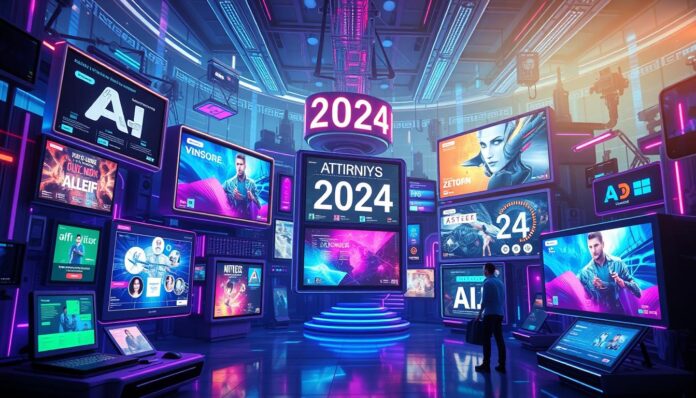Searches for “AI advertising” have jumped by 557% in two years. This shows a big change in how we advertise online. As we look ahead to 2024, we must understand that things are about to get a lot more advanced.
Online marketing will focus more on using artificial intelligence. This will make ads more efficient and personal. We’ll also see more short videos because people’s attention spans are short. And, mobile gaming will become a big way to connect with people.
Keeping up with these trends is key to staying ahead. AI, data, and being real on social media will change how we advertise. For a full look at what’s coming, check out the future of digital marketing trends.
Table of Contents
Key Takeaways
- AI is becoming integral in personalisation and predictive analytics.
- Short-form video content is key for grabbing attention.
- Mobile gaming is becoming a major way to connect with people.
- Brands are focusing on being real through user content and influencers.
- Data-driven strategies are vital in a world without cookies.
- Being open and sustainable is more important than ever.
The Rise of Artificial Intelligence in Advertising
Artificial intelligence is changing the way we advertise. It brings new ways to make ads more personal and use data better. More marketers are using AI to create content that fits each person’s needs.
There’s a big jump in people looking for AI in ads, up by 557%. This shows a big move towards using data to make ads better. It helps improve how ads work and makes them more enjoyable for users.
AI’s Role in Personalisation and Predictive Analytics
Personalisation is key in good marketing now. AI helps advertisers sort people into groups and send them content that fits their tastes. It uses data to guess what people might want next.
For example, emails that are made just for you can lead to six times more sales than regular emails. This shows how important it is to make ads that really speak to people.
Efficiency Gains through AI Automation
Being quick and efficient is vital in today’s fast world. AI makes things run smoother, saving time and boosting productivity. For example, AI can handle lots of data to help improve ads on the fly.
This efficiency means more money back for businesses. It also lets them change their ads fast to keep up with what people want.
Short-Form Video Content Dominates
The world of digital ads is changing fast, with short videos grabbing everyone’s attention. As people’s focus span gets shorter, marketers must change their ways. Over 25% of adults leave videos after just 10 seconds, showing how important it is to grab their interest from the start.
Consumer Attention Span and Ad Length
It’s interesting to see that shorter videos do better on many platforms. Sites like Instagram and Twitter limit videos to 30 and 45 seconds, respectively. Research shows that 26-second videos on Instagram get the most comments, showing how key brevity is.
This focus on short videos helps keep viewers interested and ensures your message hits home.
Shoppable Video Ads and Interactive Formats
Shoppable videos offer a new way for brands to link to their online stores. This format boosts engagement and makes buying easy. Instagram users watch videos weekly, and TikTok has 1.8 billion active users, making shoppable videos a must-try.
Creating videos that offer value and are easy to shop from meets what people want. For more on using social media in marketing, check out how platforms help build customer relationships through user-generated content and targeted ads.
Digital Advertising Trends: The Transition to Mobile Gaming
The gaming world is changing fast, with mobile games leading the way for advertisers. Almost 70% of gamers prefer mobile over social media. This shift is making brands rethink their strategies.
Mobile gaming offers a unique chance for ads to connect with users. It’s a place where people are more open to promotional messages.
Engagement and Attention in Gaming Environments
Mobile gaming pulls users in, making them more engaged than traditional media. This leads to better ad results. In-game ads, like interstitial and reward-based ones, are doing well.
For example, ads that offer in-game bonuses for watching are over 90% successful. This shows how effective they can be.
Types of In-Game Ads and Their Effectiveness
There are many in-game ad types, each reaching different gamers. Big names like Unilever and Coca-Cola are using these ads to get into the mobile gaming market. Some popular ad types include:
- Interstitial Ads: Full-screen ads shown at game pauses.
- Rewarded Video Ads: Ads watched for in-game rewards.
- Native Ads: Ads that blend in with the game’s look and feel.
These ads help brands reach a wide range of people. Even though app downloads are down, revenue from certain games is up. This shows a change in what players want and spend on.
As mobile gaming stays on top, advertisers need to keep improving. They must stay relevant and effective in their ads.
| Ad Type | Engagement Rate | Popular Games |
|---|---|---|
| Interstitial Ads | 70% + | Mid-core Games |
| Rewarded Video Ads | 90% + | Casual Games |
| Native Ads | High | Hybridcasual Games |
Authenticity in Social Media Advertising
In today’s digital world, being real in social media ads is key. Younger people are more sceptical, making authenticity stand out. Studies show half of all consumers value authenticity in influencers.
This shows brands must share real messages in their ads.
The Impact of User-Generated Content
User-generated content is a big deal in social media ads. It feels real because it comes from actual customers. Research finds 75% of consumers trust this content more than ads from brands.
Using this content in campaigns helps build trust. It makes brands more relatable.
The Rise of Influencer Marketing
Influencer marketing is changing fast, driven by the need for authenticity. Gen Z, for example, values authenticity in influencers. But, some young people prefer AI influencers.
This change means marketers must adjust their strategies. Working with influencers who share your brand’s values boosts relatability. It also meets the changing desires of social media users.
For example, Harry Styles’ cosmetic line focuses on a bigger mission. It aims to promote a positive future, not just appeal to a few. Social media platforms now favour real interactions over fake content.
Brands must deal with privacy issues and the need for a perfect image. But, with the right approach, they can thrive.
The Shift Towards Data-Driven Advertising Techniques
The digital world is changing fast. Marketers must use data-driven ads to stay ahead. With privacy laws getting tougher, building direct links with customers is key. This not only follows the rules but also gives valuable insights for customised marketing.
Importance of First-Party Data in a Cookieless World
First-party data is vital in today’s world without cookies. It’s collected directly from people, helping brands create better experiences without privacy issues. Using this data well can greatly improve marketing results.
A McKinsey & Company study found a 20% ROI boost for data-driven marketing. This shows how focusing on first-party data can help businesses grow.
Strategies for Leveraging Consumer Insights
To keep up with new ad trends, using consumer insights in marketing is essential. Brands can use several ways to make the most of first-party data:
- Adjust campaigns in real-time based on how they’re doing.
- Use data models to quickly catch changes in what people want.
- Look at outside data, like how people move, to add to what you know.
- Invest in AI to quickly understand and act on what customers say.
This way, companies can make ads that really speak to their audience. Amazon and Netflix are great examples. They use data to suggest things that really appeal to their customers, boosting loyalty and engagement.
| Strategy | Description | Benefit |
|---|---|---|
| Real-Time Optimisation | Adjusting marketing strategies dynamically based on performance data. | Increases ROI through effective budget allocation. |
| Data Modelling | Enhancing traditional models to better predict consumer behaviour. | Improves understanding of customer needs. |
| External Analytics | Incorporating outside data sources for more complete insights. | Enriches in-house data analysis and decision-making. |
| AI Investment | Using technology to analyse consumer data and test strategies. | Facilitates agile marketing and swift market responses. |
Evolving Consumer Behaviour and Brand Trust
In today’s market, knowing what consumers want is key to building trust. People now want honesty in ads and for brands to show they care about the planet. Brands that truly care about the environment attract and keep customers who value real talk about their efforts.
Expectations for Transparency and Sustainability
Today, people want brands that are green and open. This change is part of a bigger trend towards eco-friendly choices. During the pandemic, many shoppers tried new brands, looking for value and convenience. Brands that share their green efforts well can earn more trust.
Building Authentic Connections through Advertising
Brands need to connect with people in real ways. They should make ads that speak to what matters to us. Using tech to personalise ads can make customers happier and more loyal. For example, Amazon’s tailored suggestions have helped it keep customers coming back.
| Consumer Expectations | Brand Strategies |
|---|---|
| Transparency in Advertising | Clear communication about sustainability practices |
| Sustainability in Branding | Utilising eco-friendly materials |
| Personalisation | Targeted marketing efforts based on preferences |
| Innovative Products | Emphasising unique and high-quality offerings |
By focusing on these areas, brands can build stronger loyalty and advocacy. This helps them stay strong even when the market changes. It’s vital for brands to keep up with what consumers want to stay relevant.
Adoption of Programmatic Advertising Developments
Programmatic advertising is changing fast, helping brands use new tech to improve their ads. The ad spend is growing, set to hit £235.7 billion by 2025. This shows the need for better ways to reach people through programmatic buying. It makes marketing better for businesses.
Benefits of Programmatic Buying
Programmatic buying is getting more popular. It uses AI for better, more flexible ads. Real-time bidding makes sure ads are placed well, helping brands be quick and effective. As people use TikTok and Instagram more, programmatic ads help brands stay in touch with their audience.
Future Trends in Programmatic Strategies
New trends will shape programmatic ads. Better analytics and data will help brands understand what people want. Programmatic ads on connected TV will also grow, becoming a big part of digital ads.
Brands will focus more on being green and telling stories that matter. They’ll also make sure ads respect people’s privacy, following rules like GDPR. To learn more about making good strategies, check out this guide on social media marketing strategy. With programmatic ads leading the way, it’s time for brands to get on board.
The Growing Importance of Voice Search Optimisation
Voice search optimisation is key for businesses to reach their audience. More than 20% of smartphone searches are now voice-based. It’s vital to adapt SEO strategies to meet these changes.
Understanding Voice Search Queries
How we search with voice assistants has changed a lot. In 2020, 27% of global online smartphone users used voice search. They often ask full questions, not just keywords.
The rise in ‘near me’ searches, up by 500% in a year, shows the need for local content. This is because nearly 60% of consumers use voice search for local businesses.
Strategies to Enhance Voice Search Visibility
To be seen in voice searches, businesses need specific strategies. Use long-tail keywords that sound natural. Make sure your site works well on mobiles, as most searches are now mobile.
Focus on local SEO, as 60% of consumers search for local businesses by voice. Using structured data can increase clicks by 35%. Highlighting featured snippets helps give quick answers, fitting voice search well.
| Statistic | Value |
|---|---|
| Percentage of smartphone searches from voice | 20% |
| Global online smartphone users utilising voice search (2020) | 27% |
| Growth of ‘near me’ voice searches | 500% |
| Monthly voice searches in 2023 | 1 billion+ |
| Adults using voice search daily | 50%+ |
| Users of smart speakers and voice assistants in 2023 | 4.2 billion |
| Predicted number of voice assistants in use (2024) | 8.4 billion |
Social Media Advertising Insights for 2024
In 2024, keeping up with new social media platforms and trends is key. Today, 62.3% of the world uses social media, making it vital for marketing. Instagram is set to add 50 million users, reaching 1.4 billion. TikTok is also growing fast, with an 8% increase expected, reaching 900 million users.
This growth means big opportunities for advertisers to reach different audiences. It’s important to have strategies that work well across various platforms.
New Platforms and Emerging Trends
New social media sites are gaining popularity, mainly among the young. For example, over half of Gen Z uses TikTok to search for things. This shows how important it is for advertisers to explore new ways to connect with people.
The creator economy is also booming, with a forecasted growth to $74 billion this year. Brands need to use these platforms for influencer partnerships and creating content. Also, 82.7% of US marketers plan to use influencer marketing, showing a shift in consumer preferences.
Adjusting Strategies for Changing Algorithm Impact
Brands need to keep updating their ads to stay visible with algorithm changes. Tools with AI help understand what people want in real-time. This way, ads can be more effective.
In 2024, US ad spend on social networks is expected to hit $82.88 billion. Video ads will make up 55.2% of this, making video content a key part of strategies. Also, 91% of businesses use video marketing to better connect with their audience.
Using detailed analytics is key to adjusting strategies based on results. When reviewing your digital assets, make sure your ads meet changing consumer needs. A careful approach will boost engagement and help your brand grow in the ever-changing social media world. For more on creating a strong digital marketing strategy, check out these guidelines.
| Social Media Platform | Projected User Growth (2024) | Key Advertising Features |
|---|---|---|
| +50 million users, reaching 1.4 billion | Reels, Shopping, Influencer Marketing | |
| TikTok | +8%, reaching 900 million | Video Ads, Search Capabilities, Lower CPM |
| YouTube | Stable growth with top visit duration | Long-Form Content, Video Ads |
Conclusion
The world of digital ads in 2024 is going to change a lot. New tech and how people act will shape your marketing plans. Brands need to use artificial intelligence to make ads better and more personal.
AI helps make ads that really speak to people, which is key for success. Knowing that 65% of people trust brands that use AI well is important. It shows how vital AI is for your ads.
Video ads will be big in 2024, grabbing people’s attention and getting them involved. With more people wanting ads that feel made just for them, making ads personal is key. Using many channels and being real can help you connect with your audience.
Also, remember to follow data protection rules like GDPR. As people worry more about privacy, using data right in ads is important. It makes your brand stronger.
For more tips on good practices, check out this guide on PPC ads. Keeping up with these changes will help you stay ahead in the digital world.
FAQ
What are the key digital advertising trends to watch in 2024?
In 2024, watch for artificial intelligence making ads more personal. Short-form video ads will be big, and mobile gaming will grow as an ad channel.
How is artificial intelligence shaping advertising strategies?
Artificial intelligence is changing ads by making them more personal and predictive. It helps marketers tweak campaigns based on what people do online.
Why are short-form video ads becoming more significant?
Short-form video ads are getting popular because people’s attention is short. Advertisers must make quick, engaging videos to grab viewers’ attention fast.
What role does mobile gaming play in digital advertising?
Mobile gaming is becoming a key way to reach people. It’s more popular than social media for many. Brands are seeing great results with in-game ads.
Why is authenticity important in social media advertising?
Authenticity matters a lot because young people want real connections with brands. Using real content and working with influencers helps build trust and relatability.
What is the significance of first-party data in a cookieless advertising environment?
First-party data is key with privacy rules getting stricter. It helps brands understand what people like without using third-party cookies. This way, they can make ads that really speak to their audience.
How can brands build trust with consumers?
Brands can build trust by being open and showing they care about the planet. Telling stories that show they’re ethical wins over today’s consumers and builds loyalty.
What advantages does programmatic advertising offer?
Programmatic ads target the right people, bid in real-time, and place ads well. As AI gets better, managing and growing these campaigns will get easier.
How important is voice search optimisation for brands?
Voice search optimisation is vital as more people use voice devices. Brands need to tweak their SEO to match the way people talk to devices to get seen more.
What should brands consider regarding emerging social media platforms?
Brands should be quick to adapt to new social media sites. Keeping up with algorithm changes and checking how well ads work will help keep audiences engaged.






